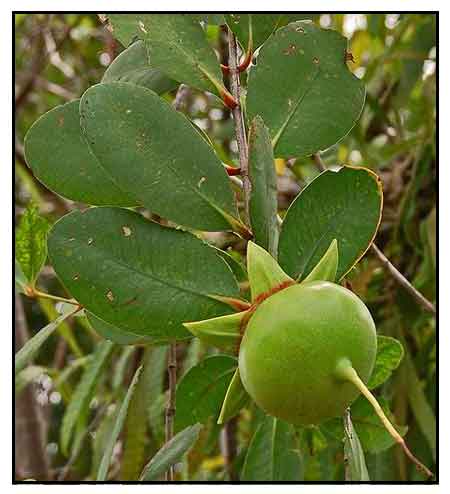 Gen info Gen info
- Sonneratia is a genus of plants in the family Lythraceae, formerly placed in the family Sonneratiaceae which included both Sonneratia and Duabanga, both of which are not placed in their own monotypic subfamilies of the family Lythraceae.
- The genus was also named Blatti by James Edward Smith, but Sonneratia has nomenclatural priority. Blatti continues its presence as an accepted synonym, Blatti caseolaris (L.) Kuntze.
- Etymology: The genus name Sonneratia honors the French botanist and explorer, Pierre Sonnerat (1749-1841). The species epithet derives from Latin caseolaris, meaning 'small cheese',
likely referring to the cheese-like taste imparted by the ripe fruit.
Botany
Hikau-hikauan is a shrub or tree reaching a height of 20 meters or less, with the trunk reaching a maximum diameter of 50 centimeters. Leaves are very thick, leathery, oblong to elliptic-oblong, 4 to 10 centimeters long, 2 to 4 centimeters wide, somewhat pointed at the tip, and tapering to a nearly blunt base. Flower is solitary. Calyx is green, 2.5 to 3 centimeters long, and comprises six segments which are longer than the tube. Petals are six, linear, pink or white, about as long as the calyx- segments. Fruit is hard, rounded-depressed, 3 to 4 centimeters in diameter, surrounded nearly to the middle by the calyx-tube; the persistent lobes are spreading. Seeds are numerous.
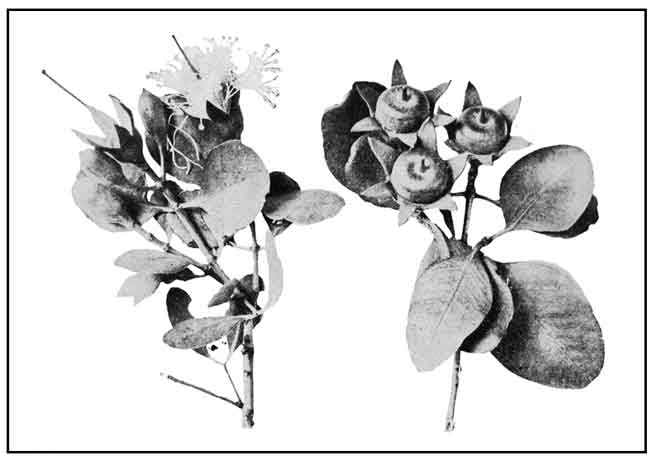 Distribution Distribution
- Native to the Philippines.
- Along small tidal streams near the limits of salt or brackish water; rarely on the open beach.
- Primarily in wet tropical biome. (2)
- Also native to Andaman Is., Bangladesh, Bismarck Archipelago, Borneo, Cambodia, Hainan, India, Jawa, Lesser Sunda, Malaya, Maluku, New Caledonia, New Guinea, Nibocar Is., Northern Territory, Pakistan, Queensland, Solomon Is., Sri Lanka, Sulawesi, Sumatera, Thailand, Vanuatu, Vietnam.
(2)
Constituents
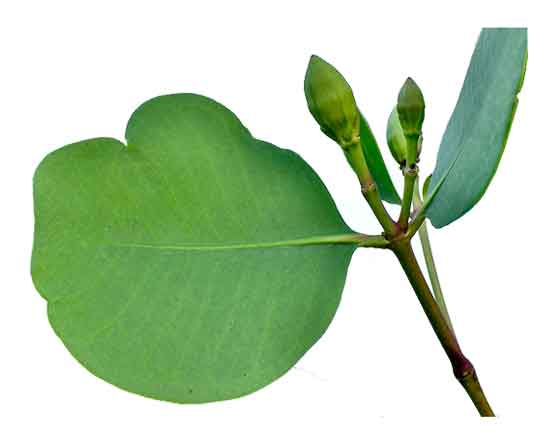 - Bark contains a moderate proportion of tannin. - Bark contains a moderate proportion of tannin.
- Yields active constituents: phenolic compounds such as gallic acid and two flavonoids luteolin and luteolin 7-O-ß-glycoside.
(6)
- Study of stems and twigs isolated twenty-four compounds, including 8 steroids (1-8), nine triterpenoids (9-16,24), three flavonoids (20-22), and four benzenecarboxylic derivatives (17-19, 23).
(see study below) (8)
- Phytochemical screening of bark tissue yielded high amounts of phenolics, flavonoids, tannins, alkaloids, and saponins.
(11)
- Study of petroleum ether extracts of roots isolated two compounds: lupeol (C30H50O) and betulinaldehyde (C30H50O2).
(14)
- Phytochemical screening of ethanolic extract of leaves yielded
flavonoid, reducing sugars, tannins and saponin types of compounds. (see study below) (10)
- Nutritional info on ripe fruits per 100g: 80 g water, 2.3 g protein, 1.0 g fat, 9.4 g carbohydrates, 5.7 g fiber, 1.6 g ash, phosphorus 50 mg, calcium 40 mg, iron 0.9 mg, and energy value 235 kJ/100 g.
(25)
Properties
- Fruit is slightly acid.
- Considered astringent and antiseptic.
- Reported antioxidant and cytotoxic.
- Studies have suggest antibacterial, antifungal, analgesic, anti-inflammatory, thrombolytic, cytotoxic, anthelmintic, antinociceptive, antidiarrheal, anticholinesterase
, antimalarial, antimelanogenesis,, CNS depressant, antidiarrheal, cytotoxic, antihyperglycemic, anti-allergic properties.
Parts used
Fruit, flowers, whole plant.
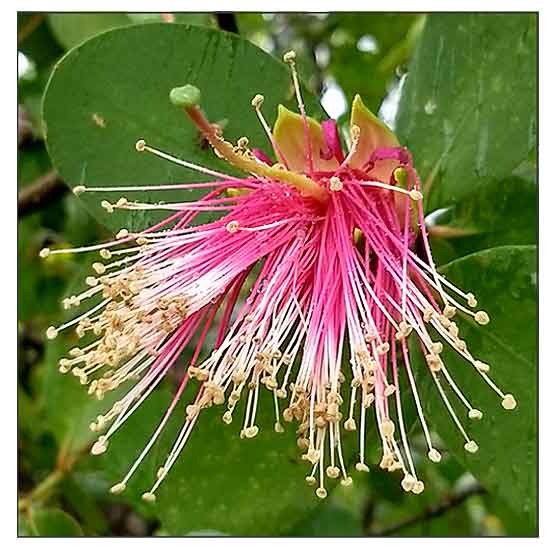 Uses Uses
Edibility
- Fruit eaten raw or cooked.
- Young fruits are sour and used as flavoring; ripe fruits have a cheesy taste.
-
Fruit, slightly acidic, used as food; also for making vinegar.
- Leaves edible, usually eaten raw.
- Fruit used to flavor curries and chutnies.
Folkloric
- Fruit used as poultice in sprains and swellings.
- Used for piles.
- Fermented juice useful in arresting hemorrhage.
- Wall of old fruit used as vermifuge.
- Half-ripe fruits used for treating cough.
- In Bangladesh, fruits used for treatment of diabetes. (20)
- In Asia, fruit and flower used for treatment of cough and parasites.
(21)
- In Thailand, whole plant decoction drunk to treat diarrhea. (23)
Others
- Crafts: Air roots used for making wooden soles of women's slippers (korcho) and of bottle stoppers.
- Net floats: Referred to as corktree, because fishermen make fishing net floats out of the pneumatophores.
- Wood: Of poor quality for construction use. Used for pulp or fuel.
- Tannin:
Bark yields 9-15% tannins (dw) and used for tanning leather and nets. (25)
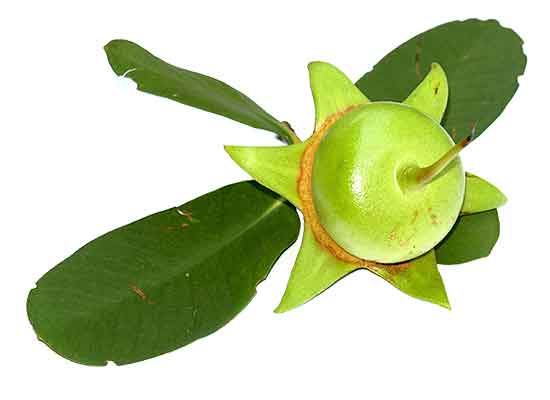 Studies Studies
• Antimicrobial / Cytotoxicity: Study isolated nine compounds from the fruits of S caseolaris. Screened against a rat glioma C-6 cell line, compounds 1, 2 and 6 were found to show moderate cytotoxic activity and suggests a potential foundation for further chemotaxonomic studies. (1)
• Flavonoids / Antioxidant: Study of S. caseolaris extract yielded two flavonoids, luteolin and luteolin 7-O-B-glucoside. Both compounds exhibited antioxidant activity on DPPH assay. (2)
• Antioxidant: Of 57 samples of 32 species tested, the calyces of Sonneratia caseolaris exhibited strong antioxidant activity followed by stamens of S. caseolaris. It also exhibited strong anti-lipid peroxidation. (3)
• Antimicrobial / Seed: A methanolic seed extract showed inhibition of Staphylococcus aureus and Candida albicans. Gallic acid showed activity against only S. aureus. Tested extracts showed antibacterial activity against Propionibacterium acnes. (6)
• Oleanolic Acid / Antihyperglycemia / α-Glucosidase Inhibitory Activity / Fruits: A methanolic extract of fruit of Sonneratia caseolaris showed moderate intestinal α-glucosidase inhibitory. Study isolated three compounds: oleanolic acid, ß-sitosterol=ß-D-glucopyranoside and luteolin. (7)
• Cytotoxicity / Stems and Twigs: Study of stems and twigs isolated 24 compounds. In in-vitro cytotoxic assay against SMMC-7721 human hepatoma cells, compound 21 (3′,4′,5,7-tetrahydroxyflavone) exhibited significant activity. (see constituents above) (8)
• Cytotoxic Compounds / Fruits: Study isolated nine compounds from the fruit of S. caseolaris. (-)-(R)-nyasol (1), (-)-(R)-40-O-methylnyasol (2) and maslinic acid (6) were found to show moderate cytotoxic activity against a rat glioma C-6 cell line. (9)
• Antinociceptive / Antioxidant / Leaves: Study evaluated an ethanolic extract of leaves for antinociceptive and antioxidant activities. Results showed statistically significant writhing inhibition in acetic acid induced writhing model in white albino mice. On DPPH scavenging assay, the antioxidant activity was comparable to standard ascorbic acid. (see constituents above) (10)
• Antimicrobial / Antioxidant / Bark: Study suggests Sonneratia caseolaris bark is a potential source of bioactive compounds with stable antimicrobial and antioxidant properties, with potential for use as antimicrobial/antioxidative agents for clinical, pharmaceutical and food processing applications. (11)
• Antinociceptive / Antidiarrheal / Leaves: Study screened a crude ethanol extract of leaves for antinociceptive and antidiarrheal activities. Results showed significant writhing inhibition in acetic induced writhing in mice, with diclofenac sodium as standard drug. In castor oil induced diarrhea in mice, there was increased latent period and significant decrease in frequency of defecation. Loperamide was used as standard. (12)
• Anticholinesterase / Antioxidant / Seed: Tacrine, stamen extract and seed extract by maceration using methanol showed noncompetitive inhibition on acetylcholinesterase activity., while luteolin, luteolin glycoside and calyx extract seed extract showed partial noncompetitive inhibition on acetylcholinesterase activity. Methanol extract of cork tree seed showed moderate antioxidant activities, with low IC50 value close to luteoline and presented noncompetitive inhibition effect on electric eel AChE. (13)
• Antimicrobial / Antioxidative / Bark: Study evaluated the antioxidative (DPPH) and antimicrobial (Bacillus subtilis, B. coagulans, Escherichia coli, Proteus vulgaris and Saccharomyces cerevisiae) properties of various S. caseolaris bark extracts. Results showed the SC bark as a potential source of bioactive compounds with stable antimicrobial and antioxidant properties. (16) In a study of 52 traditionally used Thai medicinal plants, S. caseolaris showed potential antioxidant activity and antimicrobial activity against Pseudomonas aeruginosa and Candida albicans. (17)
• Antimelanogenesis / Leaves: Study of ethanol extract of leaves of Sonneratia caseolaris showed anti-melanogenesis activity in melanin biosynthesis assays using B16 melanoma cells. Fractionation isolated an active compound, luteolin-7-O-?-glucoside (compound 1) which showed a dose-dependent inhibitory activity in melanin formation inhibitory assay. It also showed potent anti-oxidative stress activity with significant intracellular H2O2-scavenging activity in HaCaT cells. (18)
• Analgesic / Antidiarrheal / Leaf and Stem: Study evaluated various fractions of crude ethanol extract of leaf and stem for analgesic and antidiarrheal activities. The ethyl acetate fraction showed most significant antidiarrheal activity on castor oil induced diarrhea model in mice. Both EA fraction of stem and chloroform fraction of leaf showed significant analgesic activity using acetic acid induced writhing assay in mice. (19)
• Antihyperglycemic / Fruits: Study evaluated the anti-hyperglycemic potential of methanol extract of C. zedoaria and fruits of Sonneratia caseolaris. The methanolic extract of fruits of SC showed significant and dose-dependent reduction in serum glucose concentrations. Maslinic acid, reported from the fruits of S. caseolaris, have been shown to have moderate glucosidase inhibitory effect. (20)
• Hepatoprotective: Study investigated various parts of S. caseolaris for hepatoprotective activity in HepG2 cells using MTT assay for cell viability determination. All crude extracts could protect cell damage against chloroform toxicity. Hepatoprotective activities were increased in ME from sepal, seed skin of fruit, persistent calyx, pneumatophore, stamen and meat of fruit, respectively, at concentration of 50 µg/ml. Sepal could inhibit chloroform toxicity in a concentration dependent manner higher than silymarin. (21)
• Antimalarial
/ Plasmodium berghei / Leaves: Study investigated the antiplasmodial properties of methanol leaf extracts of three mangrove plants viz., A. ilcifolius, Sonneratia alba, and Sonneratia caseolaris against Plasmodium berghei strain ANKA infected into Balb-C mice. All three methanol leaf extracts showed potential antimalarial activity (S. alba showed the highest activity). (22)
• Potential of Response of GABAa Receptors / Neuropharmacological Effects: Study evaluated alcohol extracts of 11 Bangladesh medicinal fruits and plants for neuropharmacological effects in mice and on inotropic y-aminobutyric acid receptors (GABAa receptors). Four extracts, including S. caseolaris, significantly potentiated the GABA-induced response of GABAa receptors expressed in Xenopus oocytes. In mice, the extracts prolonged pentobarbital-induced sleeping time. Potentiation of GABAa receptor response is known to generate anxiolytic, sedative, sleep-inducing and anesthetic activities in the human brain. (24)
• Antioxidant / Cytotoxic / Antibacterial
/ Leaf and Stem: Study evaluated the antioxidant, cytotoxic, and antibacterial potentials of fractions (ethyl acetate, chloroform and carbon tetrachloride) of crude ethanolic leaf and stem extracts of S. caseolaris. In DPPH assay, the EA fraction of leaves was most potent (IC50 12.0 µg/ml. EAFS and carbon tetrachloride (CTFL) fraction of stem showed highest inhibitory effect against Salmonella strains with zones of inhibition of 8-11.5 mm. Cytotoxity testing by brine shrimp lethality assay showed the EAFS and CTFS demonstrated lowest LC50 (25.0 and 25.0 µg/ml, respectively). (27)
• Antidiarrheal / CNS Depressant / Blood Coagulant Effect / Anthelmintic / Fruits: Study evaluated ethanol extract of fruits for various phamacological effects. In castor oil-induced diarrheal method, the SCE significantly lengthened the latency of first defecation period up to 95.8 and 119.4 min, lowering of stool count by 43.3% and 64.4% at doses of 250 and 500 mg, respectively. In neuropharmacological testing using open-field method, there was significant central nervous system depressant effect with reduction in number of squares crossed by mice. Blood coagulation effect was demonstrated by significant reduction in blood clotting time. Anthelmintic effect showed significant killing of Paramphistomum cervi with death times decreasing with doses, 40.3, 36.8, and 29.9 min at 12.5, 25, and 50 mg/ml, respectively. Molecular docking analysis, maslinic acid, oleanolic acid, luteolin, luteolin 7-O-ß-glucoside, myricetin, ellagic acid, and R-nyasol showed best binding affinities with selected proteins, which might be cause of pharmacologic responses. Of the seven, only luteolin 7-O-ß-glucoside had two violations in Lipinski's rule of five. (28)
• Antimicrobial / Fruit: Study evaluated the antimicrogial activity of S. caseolaris fruit using ethyl acetate and ethanol 70% solvents. Antioxidant testing showed significant DPPH scavenging activity, 0.38% by EA solvent and 0.08% by ethanol solvent. Antimicrobial activity by EA solvent was significant (p<0.05) against E. coli and C. albicans. The 70% ethanol solvent showed highly promising activity against E. coli, S. aureus, and C. albicans (p<0.05). Results suggest potential use as natural antioxidant / antimicrobial agents in clinical, pharmaceutical, and food processing industries. (29)
• Anti-Inflammatory / Analgesic / Thrombolytic / Leaf and Bark: Study evaluated the pharmacological effects of bark and leaf using different system assays in mice. For anti-inflammatory activity, the crude methanol extract showed highest inhibition of paw edema in leaf (58.24%) at 100 µg/ml, in bark (40.80% inhibition) at 200 µg/ml. Analgesic effect was most potent with the leaf with % inhibition of 25.93% at 100 µg/ml, and in bark highest % inhibition of 33.33 at 100 µg/ml. The crude MEs of leaf and bark showed thrombolytic activity with clot lysis %0 of 26.27 and 44.67% of leaf and bar at concentrations of 20, 10, 5, and 2.5 mg/ml. (30)
• Anti-Allergic / Antihyperglycemic / Fruits: Study evaluated S. caseolaris fruits for toxicity, antihyperglycemic, and anti-allergic potentials. No major toxicity was observed in both acute (up to 3 g/kbw) and sub-acute toxicity (500 mg/kg daily for 14 days) studies. Oral administration of the extract significantly ameliorated TDI-induced allergic symptoms like sneezing, scratching, swelling, redness, and water rhinorrhea in mice. In oral glucose tolerance test (OGTT) and STZ-induced diabetic mice, the extract showed significant reduction in blood glucose, creatinine, BUN, bilirubin, cholesterol, SGOT and SGPT levels. (31)
• Anti-Aging / Antioxidant / Leaves: Study evaluated the anti-aging activity in-silico and in-vitro of leaf extract. Metabolite profiling on HR-LCMS yielded luteolin, betaine, and choline. DPPH assay showed IC50 of 28.214 ppm, ABTS showed IC50 1.528 ppm and FRAP 345,125 mM/g sample. According to molecular docking results, compound luteolin showed lowest binding scores with most of the target proteins: ROS (-8,3), collagenase (-11), and hyaluronidase (-6.8). Results suggest potential to be developed as an anti-aging drug. (32)
• Hypoglycemic / Dietary Fiber from Fruit Flour: Study evaluated the hypoglycemic effect of dietary fiber from Pedala Fruit Flour (PFF) in alloxan-induced diabetic rats. The PFF was formulated in three concentrations of 3, 6 and 9%. Four weeks of dietary fiber from PFF decreased blood glucose in the diabetic rats, the most effective at 9%, which approached the value of glibenclamide. All treatments increased body weight of the rats. The SCFAs (short chain fatty acid) profile in all caecum treatment of rats were inn similar concentration order: acetic acid > propionic acid > butyric acid. (33)
• Pasting Properties Mixtures of Fruit Flour and Starches: Fruits from S. caseolaris can be an important raw material in functional food with dietary fiber, vitamins, flavonoids, with hypolipidemic and antidiabetic properties. Study evaluated pasting properties mixing mangrove fruit flour (Mang) with waxy maize starch (WaMa), potato starch (PS) and wheat flour (WhF) in measures of temperature, viscosity, etc. Mixing Mang with WaMa, PS, and WhF did not change the pasting patterns or viscograms, but pasting parameters were mostly reduced with increase of mangrove fruit flour. Results suggest the mangrove fruit flour can be used in food products that do not require expansion such as food bars and biscuits. For fiber and protein enrichments, mangrove fruit flour can be extruded in a cereal mixture. (34)
• Cosmetic Potential as Peel Off Gel Mask: Study evaluated the cosmetic potential of pedada fruit as a peel off gel mask measuring physical properties, storage stability, and irritation potential at concentration of 5% with different bases (PVA, Carbomer 940 PVA+PVP). Results suggest the peel off gel mask with better physical properties and more storage stability is the formula 1 with PVA base. (35)
Availability
Wild-crafted.
|

![]()




 Distribution
Distribution
 Uses
Uses
